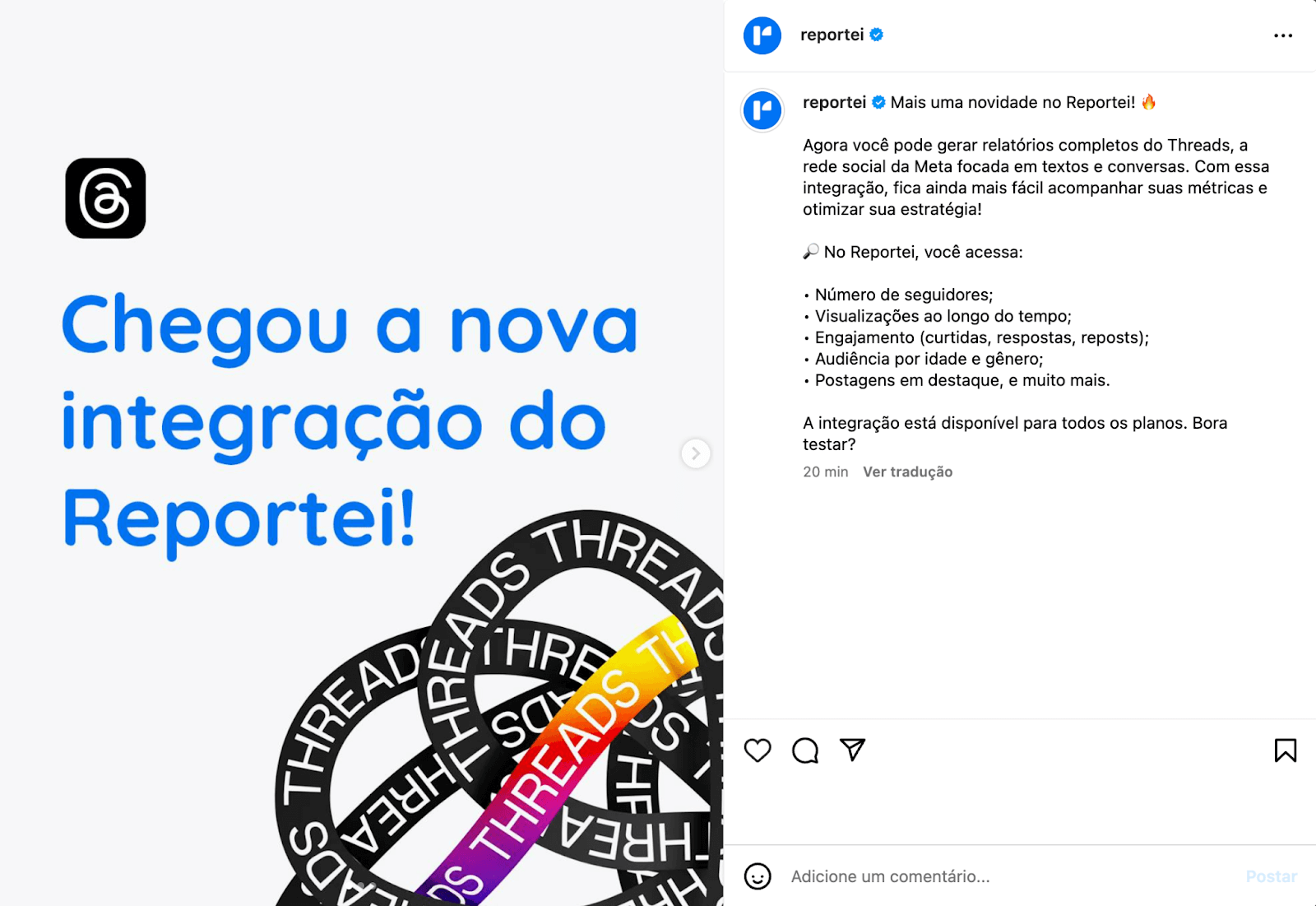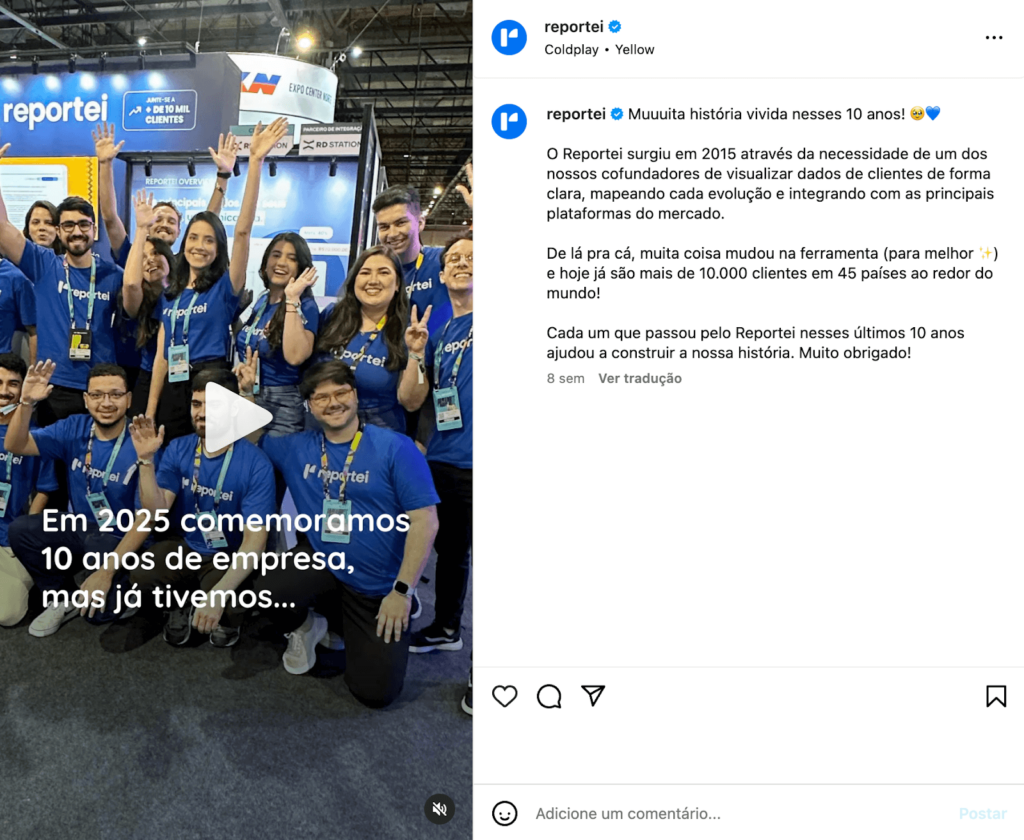Understand the role of captions for photos on Instagram and check out valuable tips to create yours more strategically.
If you’ve ever wondered how many words to use in your captions for photos on Instagram know that this is a common question.
On one hand, there are creators who bet on long-form texts to share stories, reflections, or detailed information. On the other hand, there are those who prefer shorter, more objective, and to-the-point captions.
But after all, which strategy truly works? In this article, we’ll explore the importance of captions on Instagram, understand how the algorithm can be influenced by them, and offer valuable tips for creating texts that generate engagement. Follow along.
What is the importance of captions for photos on Instagram?
To start, it’s essential to understand that the caption is much more than just a space to write something about the image or video. It complements the visual content, helps tell stories, and can be crucial for increasing engagement.
In other words, the photo caption on Instagram plays a crucial role in capturing the audience’s attention,, arousing curiosity, or even generating reflections and conversations in the comments.
Furthermore, when we talk about this social network specifically, we’re no longer dealing only with static photos, videos, reels, and stories also make up part of the ecosystem.
Thus, each content format opens up a range of possibilities for creating texts that increase interactions.
However, for captions to be strategic, it’s essential to assess the message’s suitability to your audience as well as the need to personalize the tone of voice and narrative, as we’ll see in more detail below.

How the Instagram algorithm can be influenced by captions
However, before we go to the tips, it’s essential to understand how photo captions on Instagram can impact the algorithm and make it work in your favor.
Thus, some factors that can influence this include:
- Time spent on content the longer people spend reading your caption, the better the signal of relevance you send to the algorithm. Thus, a well-crafted text with a beginning, middle, and end can lead the audience to spend more time reading.
- Engagement inviting captions that encourage interaction tend to generate more comments and even shares. Direct questions or requests for opinions are examples of how a caption can stimulate audience participation.
- Relevance and consistency using keywords related to your niche and coherent hashtags is also important. By addressing topics relevant to your audience, you increase the probability of engagement.
- User experience Instagram also evaluates whether the content is appreciated or if it generates a negative experience, such as offensive captions or spam. Therefore, maintaining a clear, objective, and valuable text for readers helps achieve better positioning.
In summary, the Instagram algorithm is not only paying attention to the image or video but also to what you write in captions for photos, stories, and reels.
After all, it’s the combination of all the post’s elements that shapes the experience of those consuming your content.
Long captions vs short captions: when to use each format
Moreover, one of the big questions for content creators is knowing when it’s worth writing a long caption and when to focus on something more succinct.
The answer to this question will depend on several factors, such as your audience’s profile, the goal of your post, and the message you wish to convey. Thus,
Long captions
They are ideal when you want to share personal or professional stories, deep reflections, detailed information, or any type of educational content.
Therefore, if you have a lot of relevant things to say, writing a longer text can be advantageous, as long as it’s well-structured and keeps the reader interested until the end.
Short captions
Work well when your image or video already conveys most of the message, and you just need to complement or create a quick hook to stimulate interaction..
This strategy is also useful when your audience is accustomed to consuming quick content or when the post’s theme itself doesn’t require detailed explanations.
In both cases, it’s worth testing and analyzing engagement metrics.
Finally, if at some point you choose an automatic caption for Instagram, adapt the text to be consistent with your style, and don’t forget to check the spelling and clarity before publishing.
Strategies for creating photo captions on Instagram
Now that you know the importance of captions for Instagram, it’s time to check out some tips to facilitate the understanding of the messages you want to convey with your texts. Let’s go.
1. Pay attention to text construction
Just like in a good blog text, giving a logical structure to the caption helps the reader follow the reasoning without getting lost.
Thus, consider the following points:
- Catchy introduction start your text with a phrase that sparks curiosity or makes an intriguing statement. This motivates people to read the rest of the caption.
- Coherent development present your main point, tell a story, or share relevant data. If you’re writing a longer text, insert line breaks to facilitate reading.
- Conclusion with Call to Action (CTA) invite the reader to comment, send to a friend, or click on a link in the bio. After all, these engagement actions can make a difference in the post’s reach.

2. Create an engaging narrative
The art of storytelling can greatly bring the audience closer to you or your brand.
Therefore, instead of just describing the image, try creating a context or sharing an experience with the followers..
This strategy is especially effective when aiming to establish emotional connections with the audience, as shown in the example of the Reportei profile:

Therefore, even if it’s a short caption, try to go beyond the simple and offer the reader a bit more content that makes them identify or feel curious.
3. Define the tone of voice
The tone of voice is how you speak on social media. Therefore, it should reflect your brand’s personality or your own if you’re an independent content creator.
Thus, to define the tone of voice, it’s worth following the tips below:
- Analyze your audience if they are younger and more relaxed, you can use slang and emojis more frequently. If it’s corporate, you might prefer a more formal language.
- Maintain consistency if you tend to be humorous and spontaneous, maintain this characteristic in all captions. This creates familiarity and recognition.
- Avoid exaggerations using too much slang, emojis, or repeated punctuation can make the text tiring or unprofessional, depending on your niche.
Besides, even in the case of automatic captions for Instagram, it’s possible to adjust the text to the desired tone of voice by making small edits before publishing.
4. Use hashtags in a balanced way
The hashtags act as tags that categorize your content and help your post be discovered by new audiences. However, it’s important to use them in balance.
- Choose relevant hashtags there’s no point in filling the caption with dozens of hashtags that have nothing to do with the image or video. The more specific and relevant they are, the better the result.
- Vary the hashtags avoid using only the same ones. In other words, research trends and test different combinations to see which ones bring more reach and engagement.
- Know where to include the hashtags you can insert them at the end of the caption or even in the first comment to not visually clutter the main text.

5. Mistakes to avoid in photo captions on Instagram
Finally, some slips can compromise your caption’s quality and even harm your profile’s reach and image. Thus, pay attention to:
- Confusing or structureless texts very long captions without paragraphs, punctuation, or organization make reading tiring.
- Excess of emojis or symbols although they are fun, excessive use can clutter the text or make it difficult to understand.
- Lack of purpose before publishing, ask yourself what the intention of this caption is. If there isn’t a clear objective, reassess.
- Grammatical and spelling errors always review, especially if using an automatic caption for Instagram. After all, small errors can give an impression of carelessness.
- Hashtag spam using irrelevant or excessive options can create a bad user experience and be considered spam.
In the end, choosing between a long caption and a short caption mainly depends on your objective and the type of content you share.
There are moments when a complete story full of details enriches the publication and attracts interested readers.
In other situations, just a powerful sentence is enough to generate engagement and connection.
Thus, it’s worth testing different approaches, analyzing the results, and above all, knowing your audience well.
After all, the best caption for photos on Instagram is the one that directly talks to whoever is on the other side of the screen. isn’t it?
- Enjoyed the tips? Take the opportunity to also read How to do paid traffic on Instagram: step by step



